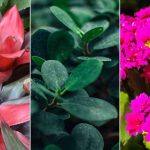10 Outdoor Plants That Thrive in Frosty Conditions Certain plants bloom in the fall and winter, offering an opportunity to infuse vibrant colors into your patio, porch, or balcony during the typically dreary months.
Creating a beautiful balcony involves more than just effort; it requires thoughtful plant selection. Many commonly placed plants on balconies or patios succumb to the first frost and fail to revive. The key lies in choosing plants that thrive in cold weather, capable of withstanding low temperatures. Today, Bekia highlights the top 10 cold-tolerant outdoor plants and flowers that not only endure but also uniquely decorate the space.
1. HOLLY
Recognized as a quintessential Christmas symbol, the green holly shrub holds protected status in certain European regions due to deforestation concerns. The common green holly, known for its frost tolerance, thrives in shaded areas during the summer and remains resilient in dry environments. Its suitability for year-round planting is enhanced by the thorny nature of its leaves. Additionally, the shrub bears fruit in the fall, providing red adornments, although they are not fit for consumption, making it an ideal decorative plant.
 This plant is protected in some areas in Europe.
This plant is protected in some areas in Europe.2. CHRYSANTHEMUM
This indigenous Chinese plant stands out for its vibrant flowers that bloom in late summer and early fall. Chrysanthemums thrive with ample moisture, well-draining organic fertilizer, and abundant sunlight. Despite its cold-resistant nature, it’s crucial to shield the plant from low temperatures and wind during the flowering week to prevent wilting.
3. JASMINE
Despite the various types of jasmine, they share similar traits. Jasmine, often suitable for walls, courtyards, or verandas, boasts a fragrant bloom typically in late spring. This plant doesn’t require daily watering, demonstrating adaptability to various soil types and resilience to cold conditions. Regarding light preferences, jasmine thrives in direct sunlight, although it can also endure some shade.
 They survive in shady areas.
They survive in shady areas.4. PERSIAN VIOLET OR CYCLAMEN
As you might expect, this tree has its origins in the Middle East, but surprisingly, it also thrives in the Alps. This unique background provides a hint that Cyclamen is among the most cold-tolerant plants. Furthermore, its flowering season spans autumn, spring, and winter, allowing you to showcase Persian violets in your garden even in chilly weather. Cyclamen produces flowers in various shades, and to encourage blooming, it requires careful attention, including adequate moisture, well-balanced fertilizer, and placement in a shaded or semi-shady location, away from direct sunlight.
5. WILD LAUREL OR DURILLO
Durillo is an uncommon dark green indigenous shrub that blooms during winter and spring, with fruiting occurring in winter and autumn. These low-maintenance, leafy shrubs are popular for garden and balcony decoration due to their appealing characteristics. Native to the Iberian Peninsula, the wild laurel is well-suited to endure sub-zero temperatures. Another advantage is its resilience to drought conditions, eliminating the need for excessive watering.
 It is a plant in dry areas that is highly durable.
It is a plant in dry areas that is highly durable.6. ORNAMENTAL CABBAGE
This plant, often referred to as ‘Decorating Cabbage,’ boasts a distinctive appearance with circular and curly leaves reminiscent of cabbage. Highly cold-tolerant, it thrives with regular watering and ample sunlight. Planting ornamental cabbage in the courtyard or a pot on the balcony is worthwhile to showcase its natural beauty. This plant blooms specifically in autumn, and its leaves attain full color during winter, making it an excellent choice for enhancing your garden’s aesthetics during colder weather.
5 Guidelines for Nurturing Your Indoor Plants
7. COTONEASTER
These shrubs often resemble holly but are smaller in size. Another distinguishing feature is the flowering period, occurring in spring for cotoneaster. The leaves may exhibit a reddish tint, and these plants do not tolerate high humidity well. Ideally placed in full sun, cotoneasters can adapt to partial shade. Commonly found in the green spaces of many cities, they are known for their resilience to heat and extreme cold, withstanding temperatures nearly 20 degrees below zero.
 Resistant to both heat and cold.
Resistant to both heat and cold.8. DAFFODIL
These flowers display a distinctive yellow hue and are remarkably cold-resistant. However, they do require protection from severe frosts. Daffodils demand careful attention as they are intolerant of excessive water. Adequate drainage is essential to prevent waterlogging. It’s important to remove withered flowers promptly to ensure the overall health of the plant. While daffodils can adapt to various light levels, they prefer semi-shade, and watering should be done sparingly. Maintaining moisture in the soil is crucial, especially when applying fertilizer.
9. IVY
Climbing plants utilized for wall coverage stand out as highly cold-resistant. Ivy, despite producing petite flowers and fruits, captivates with its lushness. This enduring plant can withstand both cold and heat conditions. Typically favoring shade, the light requirements may vary based on the specific type of ivy and the humidity levels. Ivy can tolerate water sprayed on its leaves, albeit not excessively.
https://www.shreeradheblog.tech/
 It needs shade and is moisture and water resistant.
It needs shade and is moisture and water resistant.10. LAVENDER
Lavender, a native plant of the Mediterranean, is renowned for its distinctive purple, spike-like flowers. It exhibits good cold tolerance, enduring temperatures as low as 15 degrees below zero. However, it doesn’t thrive in humid environments with excessive sunlight. An interesting feature is its relatively short lifespan of six years. Beyond its charming appearance, lavender emanates a delightful fragrance, reminiscent of sun-filled blooms.















Add Comment